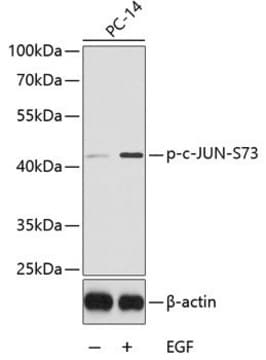06-659
Anti-phospho-c-Jun (Ser73) Antibody
Upstate®, from rabbit
Synonyme(s) :
Activator protein 1, Jun activation domain binding protein, Proto-oncogene c-jun, V-jun avian sarcoma virus 17 oncogene homolog, enhancer-binding protein AP1, jun oncogene, v-jun sarcoma virus 17 oncogene homolog, v-jun sarcoma virus 17 oncogene homolog
About This Item
Produits recommandés
Source biologique
rabbit
Niveau de qualité
Forme d'anticorps
affinity isolated antibody
Type de produit anticorps
primary antibodies
Clone
polyclonal
Produit purifié par
affinity chromatography
Espèces réactives
mouse, human
Réactivité de l'espèce (prédite par homologie)
Xenopus (based on 100% sequence homology), chicken (based on 100% sequence homology), rat (based on 100% sequence homology), bovine (based on 100% sequence homology), zebrafish (based on 100% sequence homology)
Fabricant/nom de marque
Upstate®
Technique(s)
immunocytochemistry: suitable
immunoprecipitation (IP): suitable
western blot: suitable
Numéro d'accès NCBI
Numéro d'accès UniProt
Conditions d'expédition
wet ice
Modification post-traductionnelle de la cible
phosphorylation (pSer73)
Informations sur le gène
human ... JUN(3725)
mouse ... Jun(16476)
rat ... Jun(24516)
zebrafish ... Jun(335916)
Description générale
signaling pathways. The MAP kinase homologue, SAPK/JNK, binds to the N-terminal region of c-Jun and phosphorylates c-Jun at Ser63/73. In addition, the activity of SAPK/JNK is stimulated by the same signals that activate c-Jun.
Spécificité
Immunogène
Application
A previous lot of this antibody detected 10 ng of phosphorylated gst-Jun, but did not detect 10 ng of nonphosphorylated Jun, as reported by an independent laboratory.
Qualité
Western Blotting Analysis: A 1:1,000 dilution of this antibody detected Phospho-C-Jun (Ser73) in 10 µg of Anisomycin treated NIH/3T3 cell lysate.
Description de la cible
Liaison
Forme physique
Remarque sur l'analyse
Untreated and anisomycin-treated NIH/3T3 cell lysate.
Autres remarques
Informations légales
Not finding the right product?
Try our Outil de sélection de produits.
Code de la classe de stockage
10 - Combustible liquids
Classe de danger pour l'eau (WGK)
WGK 1
Certificats d'analyse (COA)
Recherchez un Certificats d'analyse (COA) en saisissant le numéro de lot du produit. Les numéros de lot figurent sur l'étiquette du produit après les mots "Lot" ou "Batch".
Déjà en possession de ce produit ?
Retrouvez la documentation relative aux produits que vous avez récemment achetés dans la Bibliothèque de documents.
Notre équipe de scientifiques dispose d'une expérience dans tous les secteurs de la recherche, notamment en sciences de la vie, science des matériaux, synthèse chimique, chromatographie, analyse et dans de nombreux autres domaines..
Contacter notre Service technique







